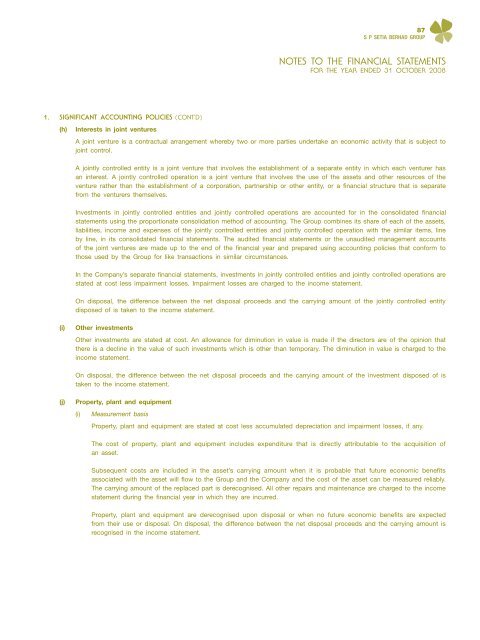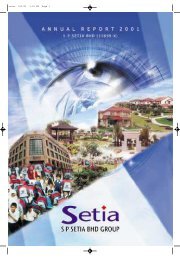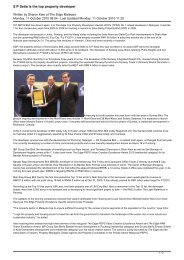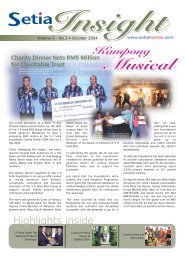Change - S P Setia Berhad
Change - S P Setia Berhad
Change - S P Setia Berhad
You also want an ePaper? Increase the reach of your titles
YUMPU automatically turns print PDFs into web optimized ePapers that Google loves.
87<br />
S P <strong>Setia</strong> <strong>Berhad</strong> Group<br />
NOTES TO THE FINANCIAL STATEMENTS<br />
FOR THE YEAR ENDED 31 OCTOBER 2008<br />
1. SIGNIFICANT ACCOUNTING POLICIES (cont’d)<br />
(h)<br />
Interests in joint ventures<br />
A joint venture is a contractual arrangement whereby two or more parties undertake an economic activity that is subject to<br />
joint control.<br />
A jointly controlled entity is a joint venture that involves the establishment of a separate entity in which each venturer has<br />
an interest. A jointly controlled operation is a joint venture that involves the use of the assets and other resources of the<br />
venture rather than the establishment of a corporation, partnership or other entity, or a financial structure that is separate<br />
from the venturers themselves.<br />
Investments in jointly controlled entities and jointly controlled operations are accounted for in the consolidated financial<br />
statements using the proportionate consolidation method of accounting. The Group combines its share of each of the assets,<br />
liabilities, income and expenses of the jointly controlled entities and jointly controlled operation with the similar items, line<br />
by line, in its consolidated financial statements. The audited financial statements or the unaudited management accounts<br />
of the joint ventures are made up to the end of the financial year and prepared using accounting policies that conform to<br />
those used by the Group for like transactions in similar circumstances.<br />
In the Company’s separate financial statements, investments in jointly controlled entities and jointly controlled operations are<br />
stated at cost less impairment losses. Impairment losses are charged to the income statement.<br />
On disposal, the difference between the net disposal proceeds and the carrying amount of the jointly controlled entity<br />
disposed of is taken to the income statement.<br />
(i)<br />
Other investments<br />
Other investments are stated at cost. An allowance for diminution in value is made if the directors are of the opinion that<br />
there is a decline in the value of such investments which is other than temporary. The diminution in value is charged to the<br />
income statement.<br />
On disposal, the difference between the net disposal proceeds and the carrying amount of the investment disposed of is<br />
taken to the income statement.<br />
(j)<br />
Property, plant and equipment<br />
(i) Measurement basis<br />
Property, plant and equipment are stated at cost less accumulated depreciation and impairment losses, if any.<br />
The cost of property, plant and equipment includes expenditure that is directly attributable to the acquisition of<br />
an asset.<br />
Subsequent costs are included in the asset’s carrying amount when it is probable that future economic benefits<br />
associated with the asset will flow to the Group and the Company and the cost of the asset can be measured reliably.<br />
The carrying amount of the replaced part is derecognised. All other repairs and maintenance are charged to the income<br />
statement during the financial year in which they are incurred.<br />
Property, plant and equipment are derecognised upon disposal or when no future economic benefits are expected<br />
from their use or disposal. On disposal, the difference between the net disposal proceeds and the carrying amount is<br />
recognised in the income statement.

















